1999 FORD E SERIES transmission
[x] Cancel search: transmissionPage 5 of 39

Fast start glow plug system
The glow plug system consists of:
²eight glow plugs
²the glow plug relay
²engine oil temperature (EOT) sensor
²barometric pressure (BARO) sensor
The glow plug system is electronically controlled by the PCM. The PCM
energizes the glow plugs immediately after the ignition is placed in the
ON position, then determines how long the glow plugs will be on
according to the EOT and BARO sensors. The required time for the glow
plugs to be energized decreases as the engine oil temperature and
barometric pressure increase.
Engine cooling system
The cooling system contains an engine oil cooler which is mounted to
the side of the cylinder block. The cooler's function is to regulate engine
oil temperature.
Engine governed speed
The engine governor is controlled by the PCM. The PCM controls fuel
input to limit maximum engine speed. It will not, however, prevent
engine overspeeding resulting from downshifting at high vehicle speed or
by descending steep grades at too high a vehicle speed for the selected
transmission gear.
For maximum vehicle speed in various gears, refer to the ªTransmission
shift speedº chart in theDriving tipschapter. Do not exceed 3,600 rpm.
Maximum engine governed speed is 3,000±4,000 rpm depending on
engine load. Excessive rpm can only be achieved by manually
downshifting at too high of a vehicle speed.
Operating the engine beyond the governed speed can cause severe
engine damage.
Diesel information
5
Page 9 of 39

STARTING THE ENGINE
Read all starting instructions carefully before you start your vehicle.
Starting procedures are also shown on the vehicle visor. For
temperatures below 0ÉC (32ÉF), the use of the correct grade engine oil is
essential for proper operation.
If your vehicle is equipped with a manual transmission, make sure the
parking brake is set fully before you turn the key. Depress the clutch
pedal and place the gearshift in the neutral position. The clutch must be
fully depressed in order to operate the starter. Do not press the
accelerator during starting.
If your vehicle is equipped with an automatic transmission, ensure the
gearshift lever is in P (Park) and the parking brake is set before you turn
the key. Do not press the accelerator during starting.
COLD WEATHER STARTING
Do not crank the engine for more than 30 seconds at a time as starter
damage may occur. If the engine fails to start, turn the key to OFF and
wait 30 seconds before trying again.
Do not use starting fluid such as ether in the air intake system (see Air
Cleaner Decal). Such fluid could cause immediate explosive damage to
the engine and possible personal injury.
Do not add gasoline, gasohol or alcohol to diesel fuel. This practice
creates a serious fire hazard and causes engine performance problems.
1. Make sure all vehicle occupants have buckled their safety belts. For
more information on safety belts and their proper usage, refer toSeating
and safety restraintschapter in the owner guide.
2. Make sure the headlamps and vehicle accessories are off.
3. Turn the key to the ON position.
When the WAIT TO START light
goes off, turn the key to START.
(For Canadian vehicles, the daytime
running lamps will be on if the
parking brake is not applied and the key is turned to ON.)
4. When the engine starts, release the key. The glow plugs will continue
to be activated for up to two minutes. If the engine is not started before
the activation ceases, the glow plug system must be reset by turning the
ignition key to OFF.
WAIT
TO
START
Starting
9
Page 14 of 39
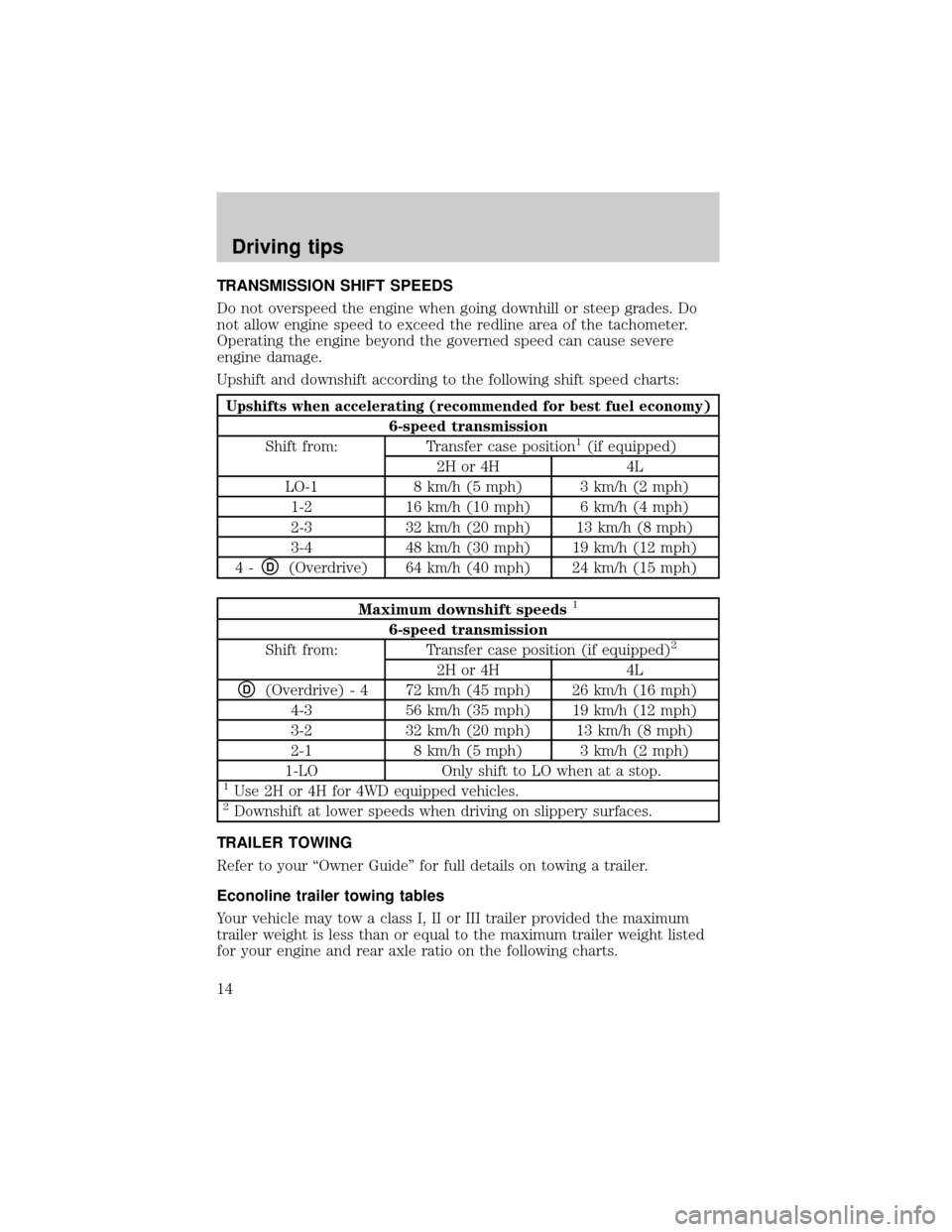
TRANSMISSION SHIFT SPEEDS
Do not overspeed the engine when going downhill or steep grades. Do
not allow engine speed to exceed the redline area of the tachometer.
Operating the engine beyond the governed speed can cause severe
engine damage.
Upshift and downshift according to the following shift speed charts:
Upshifts when accelerating (recommended for best fuel economy)
6-speed transmission
Shift from: Transfer case position1(if equipped)
2H or 4H 4L
LO-1 8 km/h (5 mph) 3 km/h (2 mph)
1-2 16 km/h (10 mph) 6 km/h (4 mph)
2-3 32 km/h (20 mph) 13 km/h (8 mph)
3-4 48 km/h (30 mph) 19 km/h (12 mph)
4-
D(Overdrive) 64 km/h (40 mph) 24 km/h (15 mph)
Maximum downshift speeds1
6-speed transmission
Shift from: Transfer case position (if equipped)2
2H or 4H 4L
D(Overdrive) - 4 72 km/h (45 mph) 26 km/h (16 mph)
4-3 56 km/h (35 mph) 19 km/h (12 mph)
3-2 32 km/h (20 mph) 13 km/h (8 mph)
2-1 8 km/h (5 mph) 3 km/h (2 mph)
1-LO Only shift to LO when at a stop.
1Use 2H or 4H for 4WD equipped vehicles.2Downshift at lower speeds when driving on slippery surfaces.
TRAILER TOWING
Refer to your ªOwner Guideº for full details on towing a trailer.
Econoline trailer towing tables
Your vehicle may tow a class I, II or III trailer provided the maximum
trailer weight is less than or equal to the maximum trailer weight listed
for your engine and rear axle ratio on the following charts.
Driving tips
14
Page 16 of 39
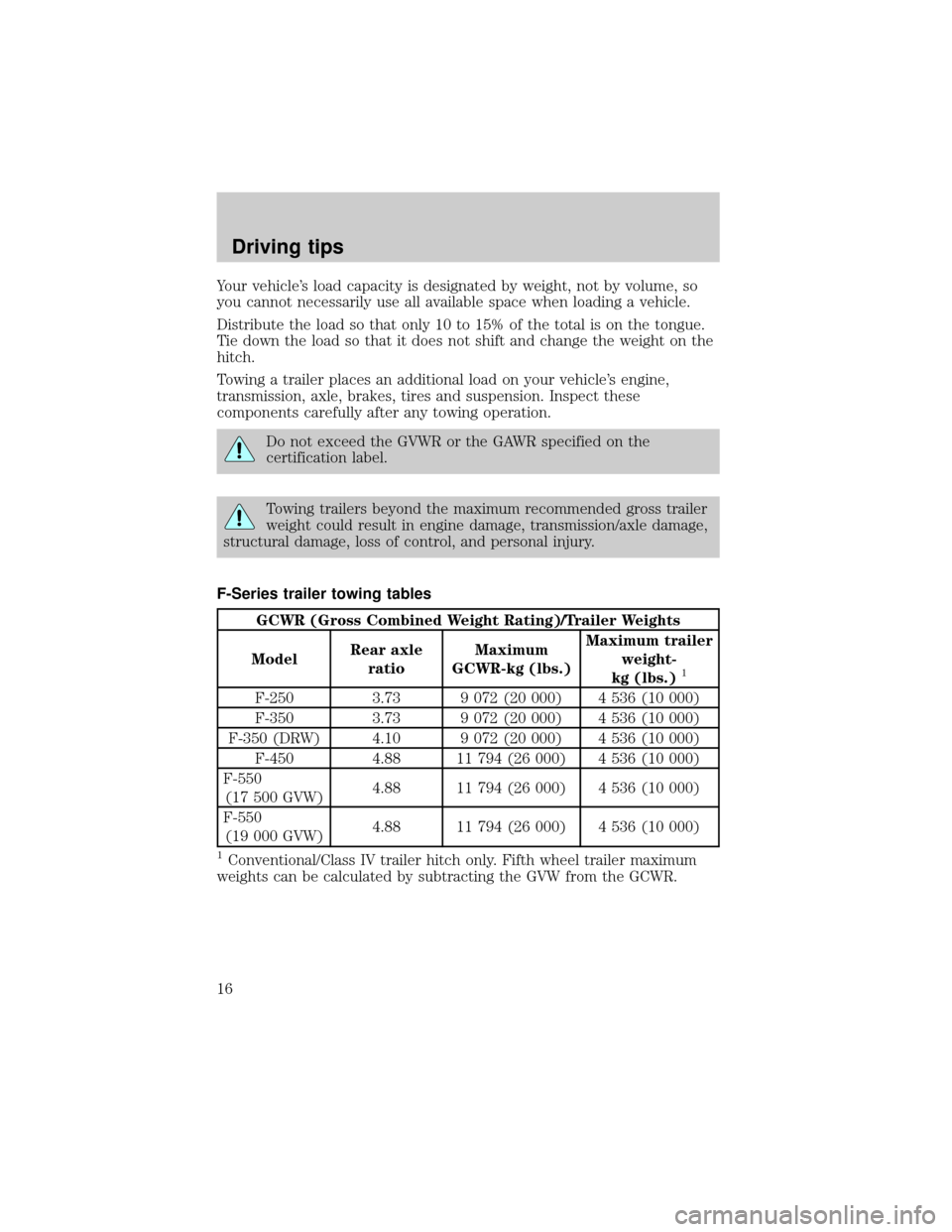
Your vehicle's load capacity is designated by weight, not by volume, so
you cannot necessarily use all available space when loading a vehicle.
Distribute the load so that only 10 to 15% of the total is on the tongue.
Tie down the load so that it does not shift and change the weight on the
hitch.
Towing a trailer places an additional load on your vehicle's engine,
transmission, axle, brakes, tires and suspension. Inspect these
components carefully after any towing operation.
Do not exceed the GVWR or the GAWR specified on the
certification label.
Towing trailers beyond the maximum recommended gross trailer
weight could result in engine damage, transmission/axle damage,
structural damage, loss of control, and personal injury.
F-Series trailer towing tables
GCWR (Gross Combined Weight Rating)/Trailer Weights
ModelRear axle
ratioMaximum
GCWR-kg (lbs.)Maximum trailer
weight-
kg (lbs.)
1
F-250 3.73 9 072 (20 000) 4 536 (10 000)
F-350 3.73 9 072 (20 000) 4 536 (10 000)
F-350 (DRW) 4.10 9 072 (20 000) 4 536 (10 000)
F-450 4.88 11 794 (26 000) 4 536 (10 000)
F-550
(17 500 GVW)4.88 11 794 (26 000) 4 536 (10 000)
F-550
(19 000 GVW)4.88 11 794 (26 000) 4 536 (10 000)
1Conventional/Class IV trailer hitch only. Fifth wheel trailer maximum
weights can be calculated by subtracting the GVW from the GCWR.
Driving tips
16
Page 34 of 39

IF THE ENGINE WON'T CRANK
Turn on the headlights. If the lights are dim, do not go on at all or if
when the ignition is turned to START the lights become dim or go out,
the battery connections may be loose or corroded, or the battery may be
discharged. If there is a clicking or stuttering sound coming from the
engine compartment when you turn the key to START, this may also
indicate a loose or corroded battery connection.
Check the battery connections at the battery posts, cable connection to
the engine grounding point and at the starter relay terminals. Also, make
sure the relay bracket is securely fastened to its mounting surface.
If the starter relay clicks, but the starter does not crank, check the
connections at the starter terminal. If a discharged battery is suspected,
have it checked and corrected.
²For vehicles with manual transmissions, the clutch pedalmustbe fully
depressed in order for the starter to operate.
²For vehicles with automatic transmissions, the gearshift lever must be
in Park or Neutral in order for the starter to operate.
²Try operating the starter switch several times. Should the switch be
corroded, this operation may clean the contacts or make the switch
temporarily operable until you can reach the dealer.
²If all electrical connections are tight and you need assistance to start,
see ªJump Starting Your Vehicleº in theStartingchapter.
IF ENGINE CRANKS BUT WON'T START
Prolonged starter cranking (in excess of 30 seconds) could cause
damage to the starter motor.
²Check the fuel gauge. You may be out of fuel. If the gauge shows that
there is fuel in the tank, the trouble may be in the electrical system or
the fuel system. If equipped with an auxiliary tank, be sure that the
tank control switch is set for the tank with fuel and not on an empty
tank.
²Leaving the ignition key ON for over two minutes without starting may
make starting difficult because the glow plugs will cease activation.
Reset the system by turning the ignition key to OFF and then back to
ON again.
Minor troubleshooting guide
34
Page 36 of 39
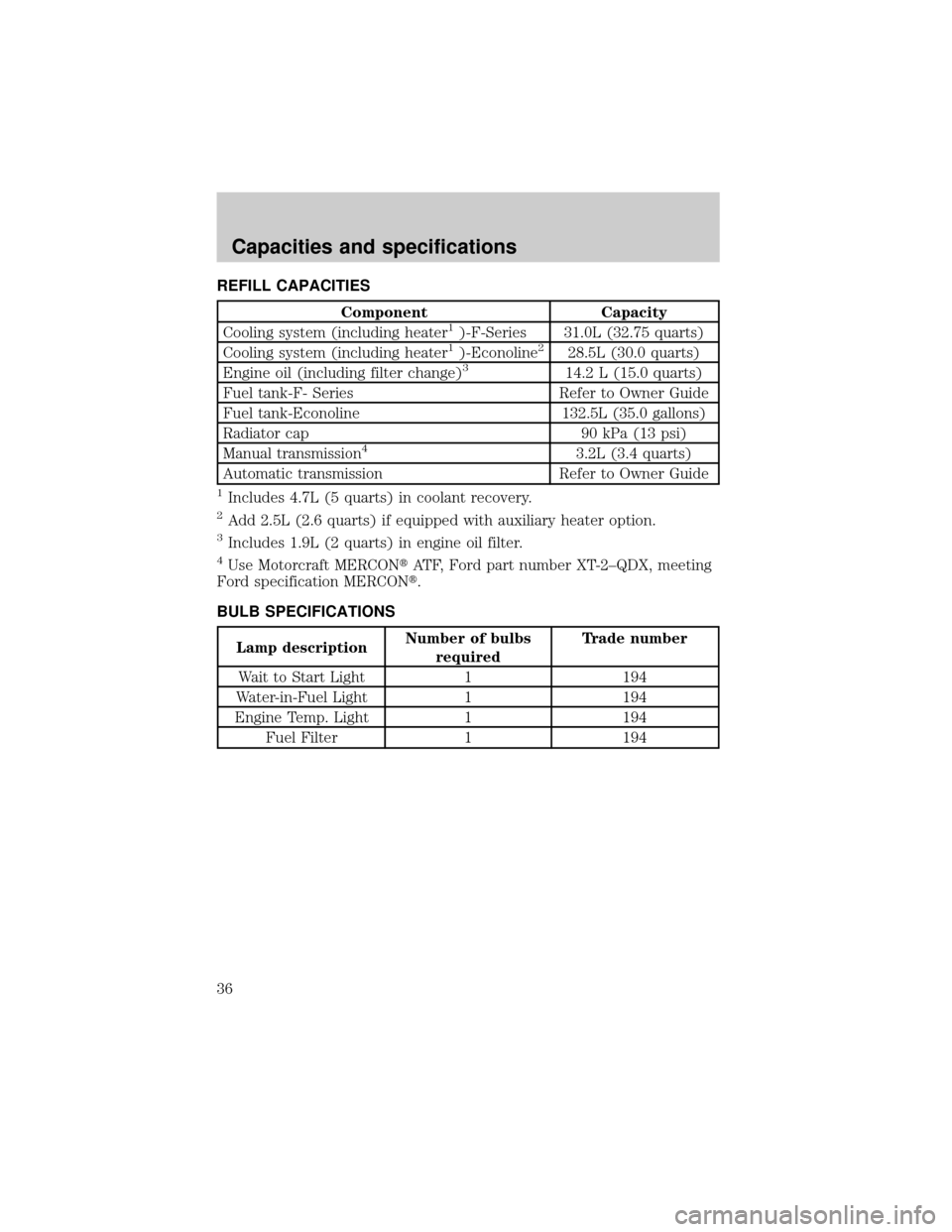
REFILL CAPACITIES
Component Capacity
Cooling system (including heater1)-F-Series 31.0L (32.75 quarts)
Cooling system (including heater1)-Econoline228.5L (30.0 quarts)
Engine oil (including filter change)314.2 L (15.0 quarts)
Fuel tank-F- Series Refer to Owner Guide
Fuel tank-Econoline 132.5L (35.0 gallons)
Radiator cap 90 kPa (13 psi)
Manual transmission
43.2L (3.4 quarts)
Automatic transmission Refer to Owner Guide
1Includes 4.7L (5 quarts) in coolant recovery.
2Add 2.5L (2.6 quarts) if equipped with auxiliary heater option.
3Includes 1.9L (2 quarts) in engine oil filter.
4Use Motorcraft MERCONtATF, Ford part number XT-2±QDX, meeting
Ford specification MERCONt.
BULB SPECIFICATIONS
Lamp descriptionNumber of bulbs
requiredTrade number
Wait to Start Light 1 194
Water-in-Fuel Light 1 194
Engine Temp. Light 1 194
Fuel Filter 1 194
Capacities and specifications
36
Page 38 of 39
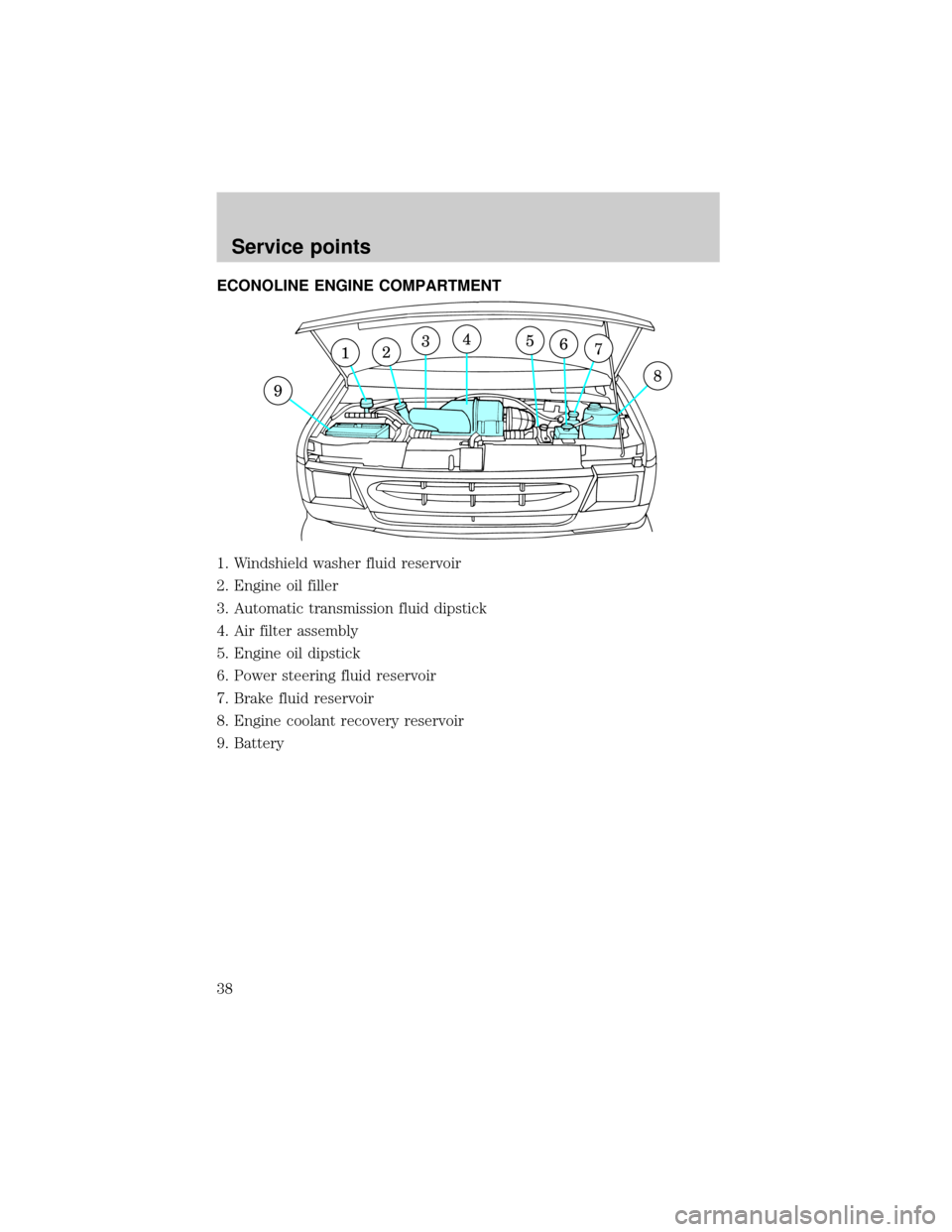
ECONOLINE ENGINE COMPARTMENT
1. Windshield washer fluid reservoir
2. Engine oil filler
3. Automatic transmission fluid dipstick
4. Air filter assembly
5. Engine oil dipstick
6. Power steering fluid reservoir
7. Brake fluid reservoir
8. Engine coolant recovery reservoir
9. Battery
91234
5
6
7
8
Service points
38
Page 39 of 39
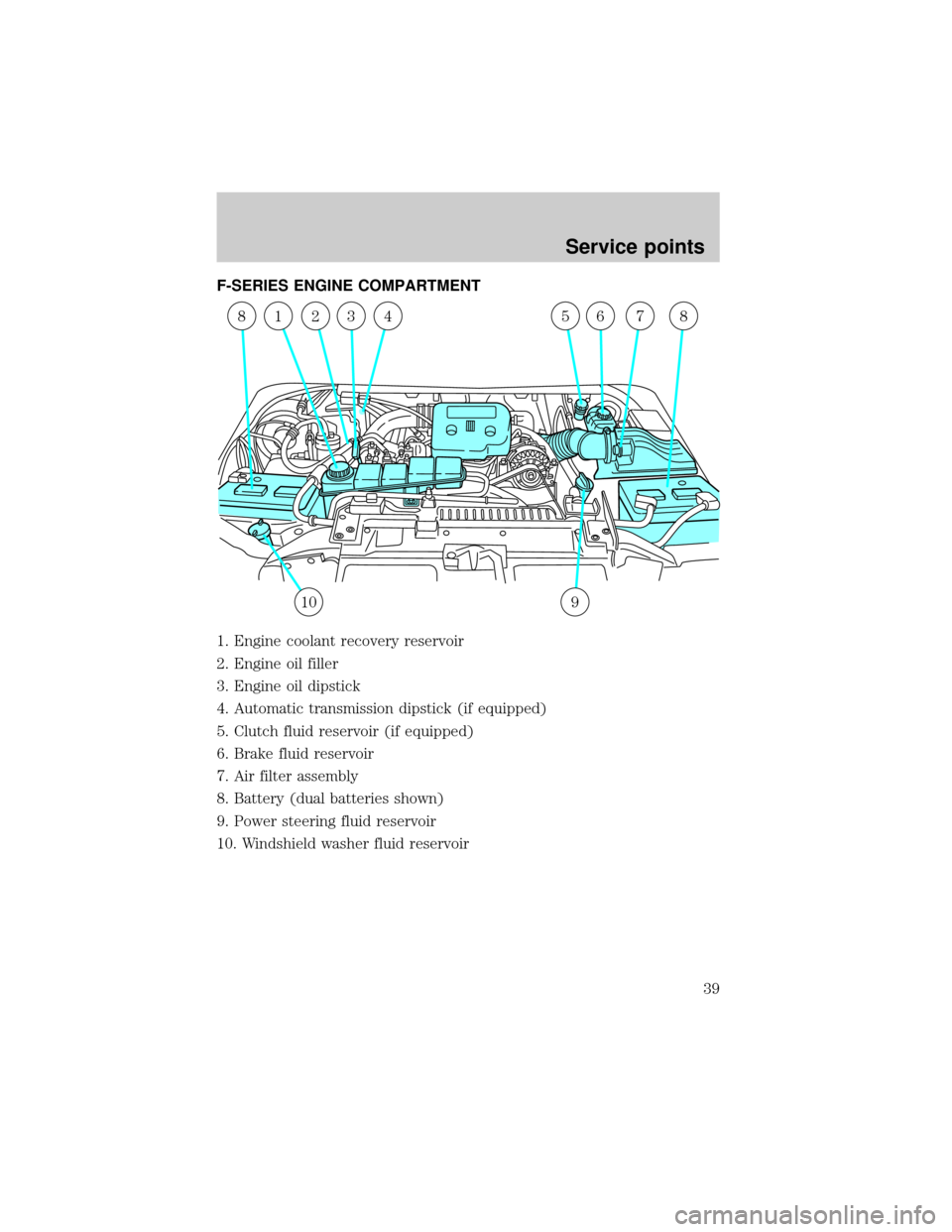
F-SERIES ENGINE COMPARTMENT
1. Engine coolant recovery reservoir
2. Engine oil filler
3. Engine oil dipstick
4. Automatic transmission dipstick (if equipped)
5. Clutch fluid reservoir (if equipped)
6. Brake fluid reservoir
7. Air filter assembly
8. Battery (dual batteries shown)
9. Power steering fluid reservoir
10. Windshield washer fluid reservoir
109
123456788
Service points
39